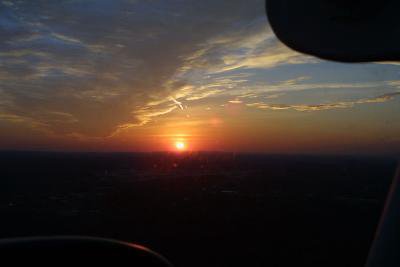Going multi -- Days 5 and 6
Yesterday afternoon we fired up the Seminole, got our ADIZ clearance and set off to Culpepper for a little engine failure practice. I did a decent short-field landing on 22 and taxied back. Normal take off, power set. Within seconds the aircraft points left. Engine failure. I retard the throttles and maintain directional control.
After a normal take off, at about 500 AGL, the Seminole yawed and rolled left again. Here is where I'm supposed to pitch for blue line (88 KIAS in this case), maintain directional control and run through the memory items (mixtures, props, throttles full forward, flaps/gear up, identify the engine out with dead foot, verify by closing the throttle, feather and cut off the mixture), declare an emergency and circle back to land.
I'd chair flown the flows over and over again and thought I'd be ready to demonstrate them in the plane. Instead, on the first engine out on take-off, I fell behind. For starters, the gear horn sounded a lot like the stall warning, which led me to pitch down too much. Caught that and returned to blue line but while I expected the memorized checklist to come out, my brain was a mess while I was trying to run through the steps and make sure I had the right engine identified.
With a little verbal help from my instructor, I got things done and was on downwind, my forehead drenched in sweat. In my defense, it was pretty warm in the Seminole yesterday.
Landing on one engine didn't trouble me too much, although I found that pulling the power out quickly over the runway WILL send the nose yawing like crazy! I resolved to pulling the throttle with a little more finesse next time.
After two circuits, my engine failure checklist was coming out more comfortably and I was executing the procedure well. My landings improved too as I managed to balance the amount of rudder correction vs. power reduction or increase, therefore keeping the aircraft pointing forward and putting it down on centerline.
We ran through engine outs for about an hour and a half, and with my instructor satisfied, headed back to Manassas.
On our way home, I took a minute to look outside, something I haven't had the luxury to do yet during our flights. A few build-ups hovered lazily over a mountain ridge to our northwest, tainted in pink by the setting sun. The sky was a mix of blues, purples and pinks and smooth as silk, giving us a pleasant evening cruise back to Manassas.
On downwind, I heard a student pilot telling the tower controler he was about to drop his instructor off and return to the runway for his first solo. My instructor and I keyed our mics and wished him good luck with a quick "woohoo." Seconds later I did a nice short-field landing and returned to the ramp in time to see the student pilot take off in the cool and peaceful evening sky.
I stood by the Seminole and watched him lift off, then turn crosswind. I smiled a little, wondering how he felt up there. As he turned downwind, I remembered my own first solo, which took place on a similar evening almost two years ago. It's a day I'll never forget for as long as I live, a moment that radically changed my life forever and one of my very fondest memories.
The student pilot turned base, then final and made a nice and stabilized approach to 16R. With no winds and little traffic on that runway, he made a nice landing, bouncing just a tad but bringing the 172 back to the ground in one piece. I smiled again and the slight tension that had inhabited my muscles as he approached the runway left me. One day soon, I might be sending someone off to fly alone for the first time. What an amazing feeling it must be, and what a tremendous responsibility...
Witnessing this solo was a special moment. I don't know the student pilot, but it made me very happy to see him fly a neat pattern and land safely. He must be over the moon. Whoever you are, congratulations! You will always remember this day: Friday Feb. 3rd, 2006.
Today, Saturday, was socked in so we went through everything for the oral portion of Monday's checkride. I'm quite comfortable with systems, aerodynamics and so on so it shouldn't be too much of a problem, even with the FSDO inspector present.
Two instructors and I also went through the inner workings of turbo props, turbo jets and turbo fans, learning about axial flow compressors and their centrigufal brethren. Obviously, this is of no use to me now but it was very interesting nonetheless and I guess it's just never to early to learn about it!
Back to studying. More flying tomorrow and Monday before the checkride.
I may take the evening off though. That'll be sweet.



1 Comments:
A good friend of mine is a pilot and has embarked on a similar journey to yours. He left a stable job, his family, and his friends to pursue a career in aviation. Though I understand it and admire him for following this dream, I have never been able to step into his shoes until now. Thank you for offering me a glimpse into this passion for flying that you two share.
Post a Comment
<< Home